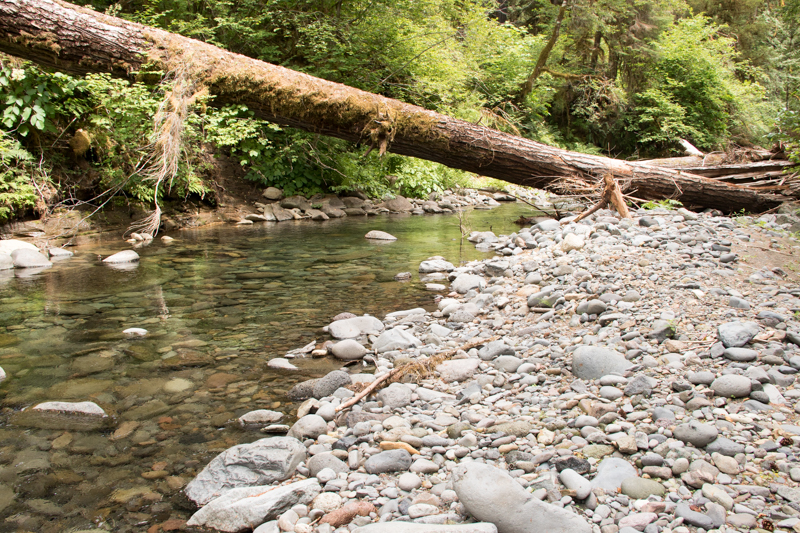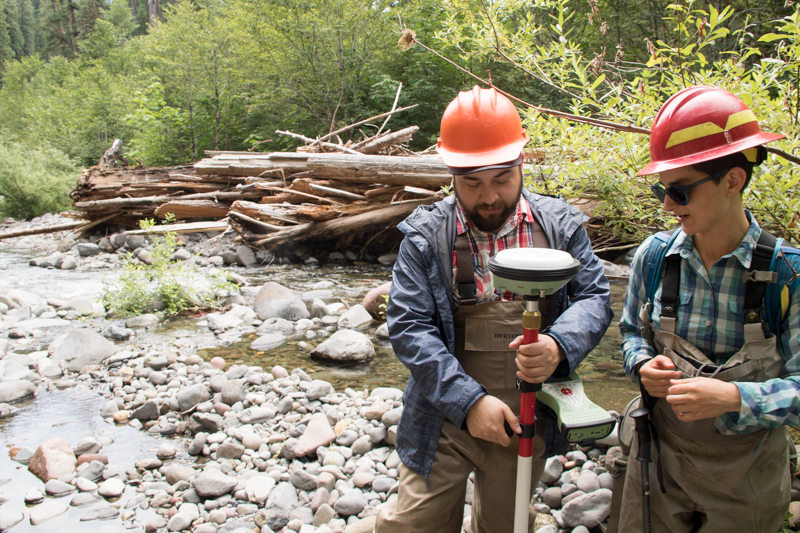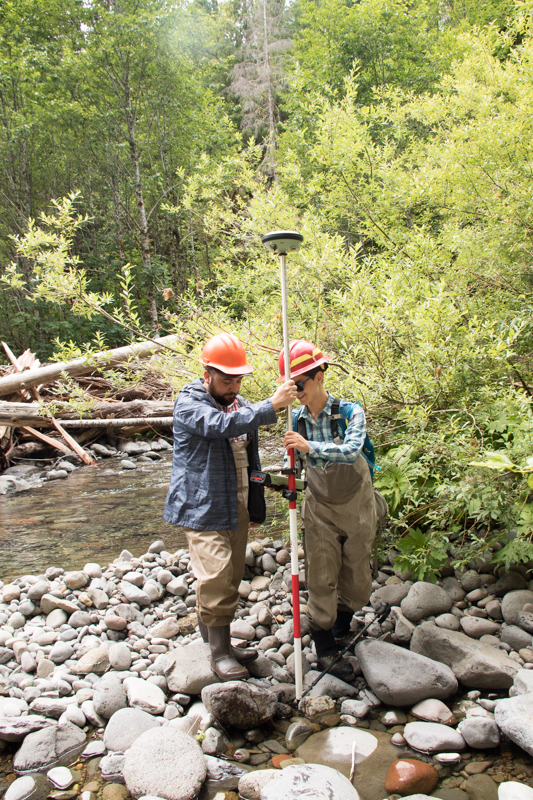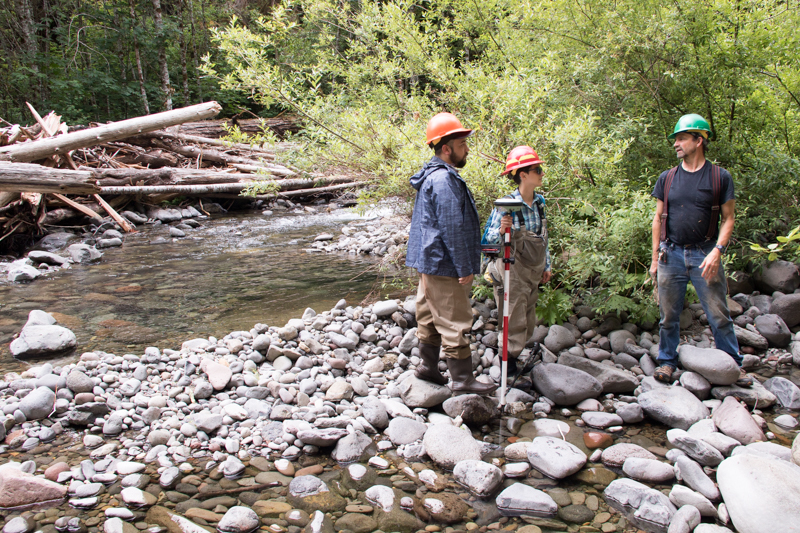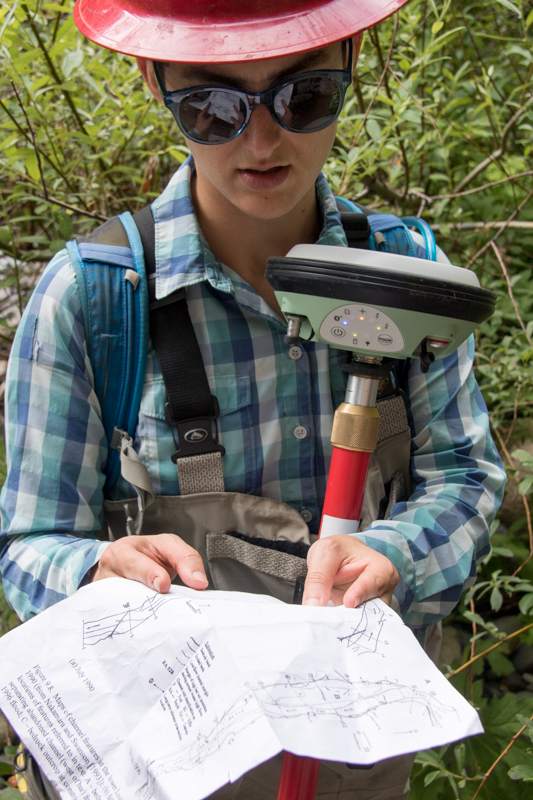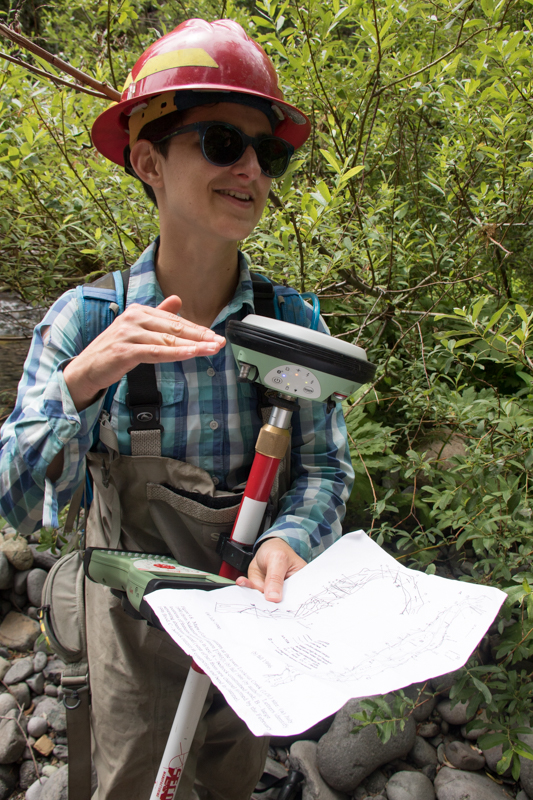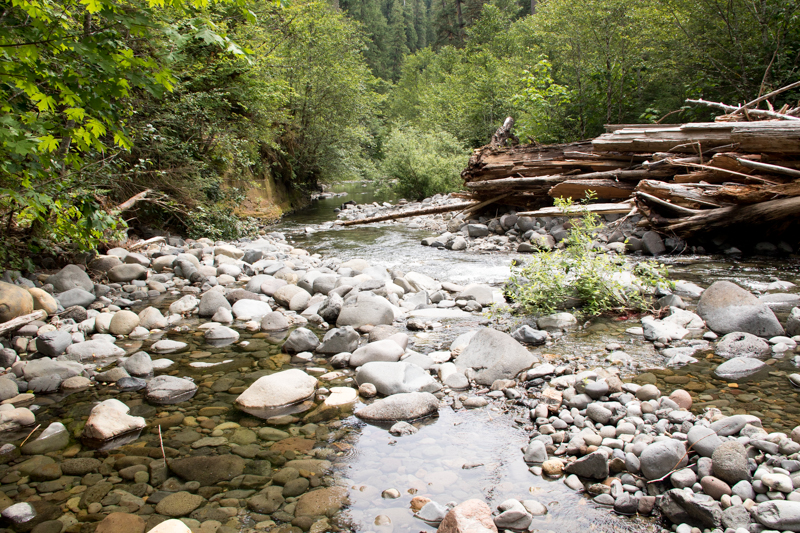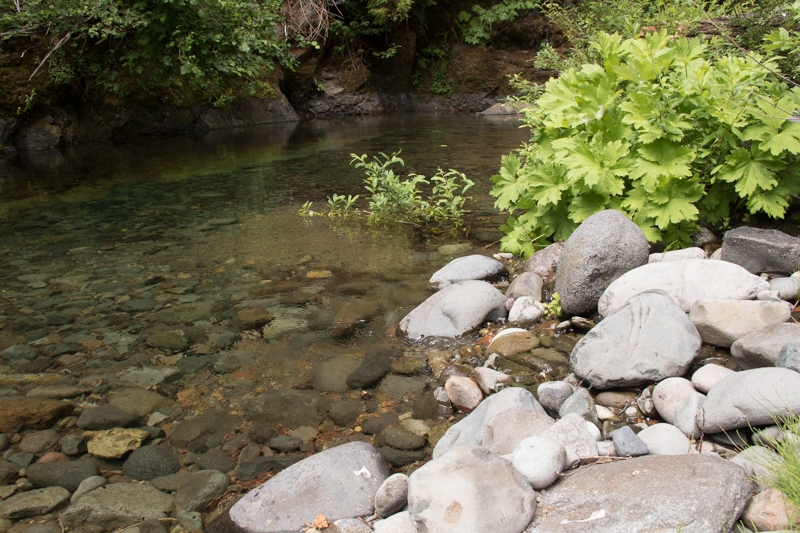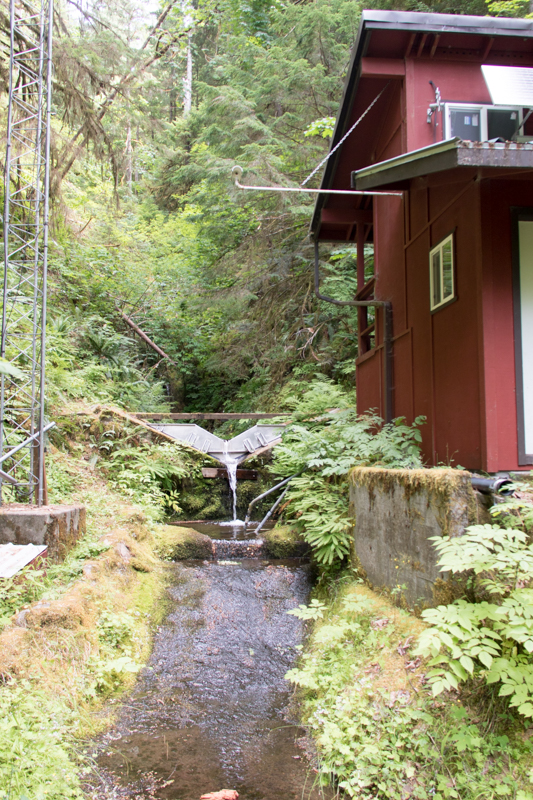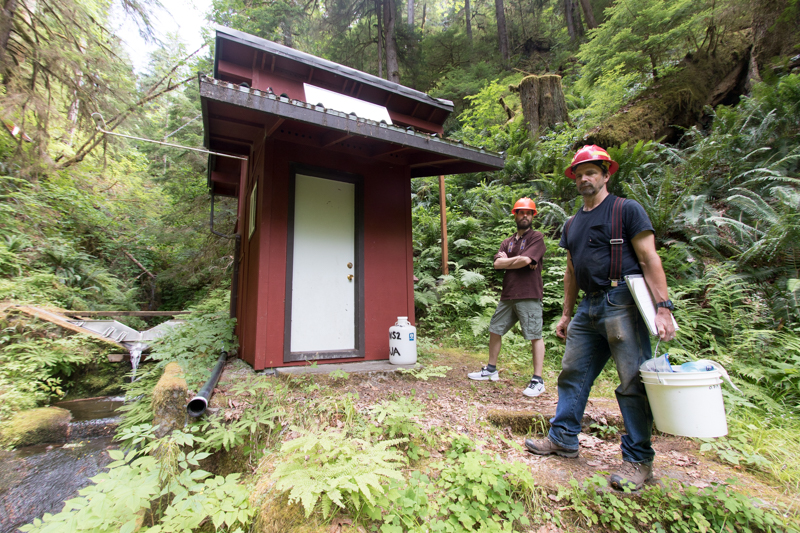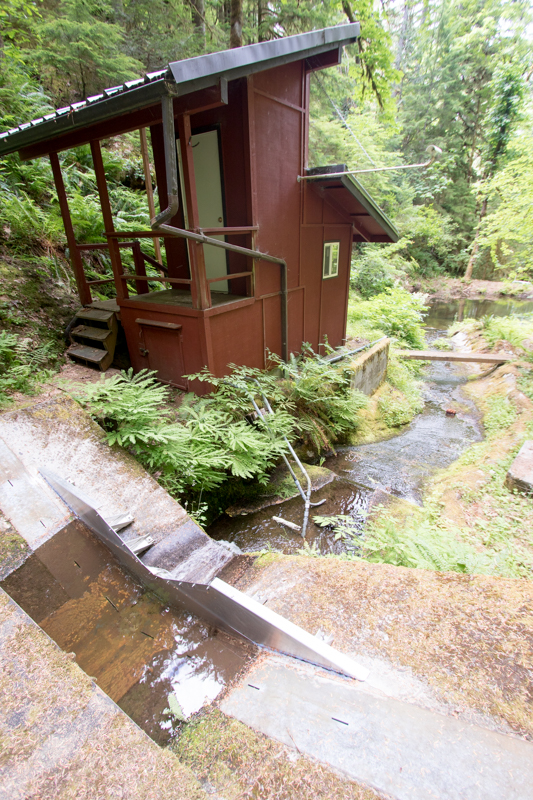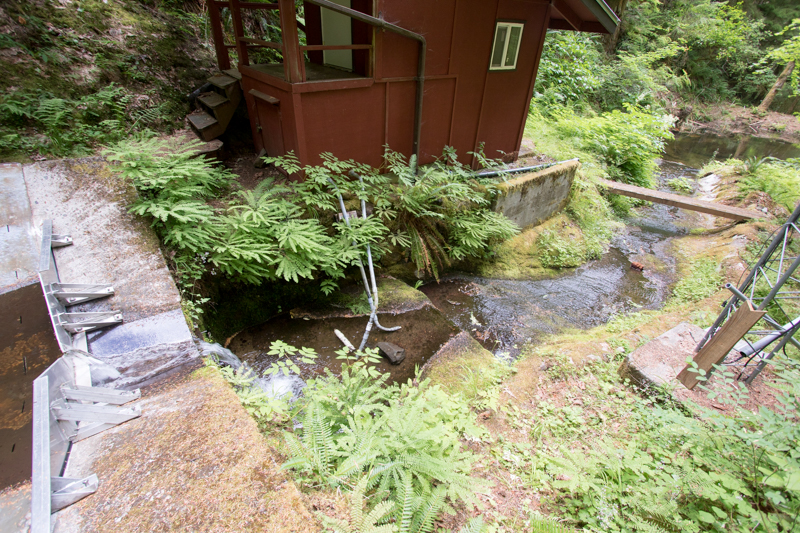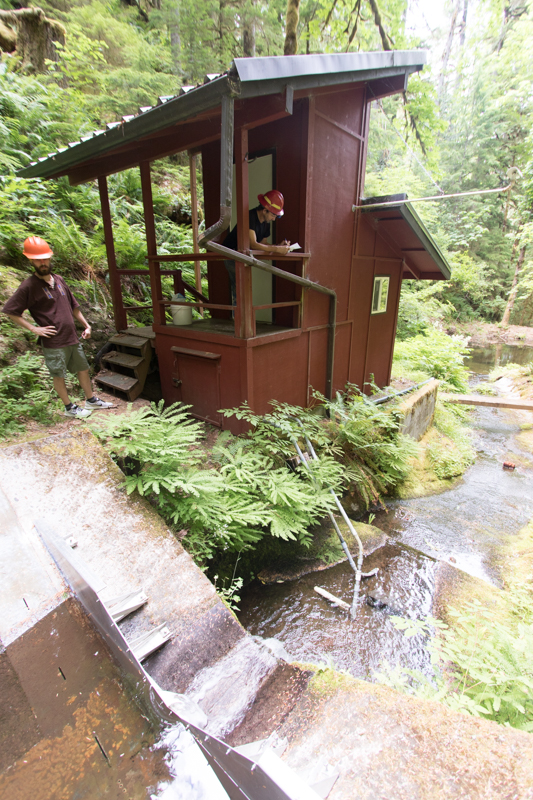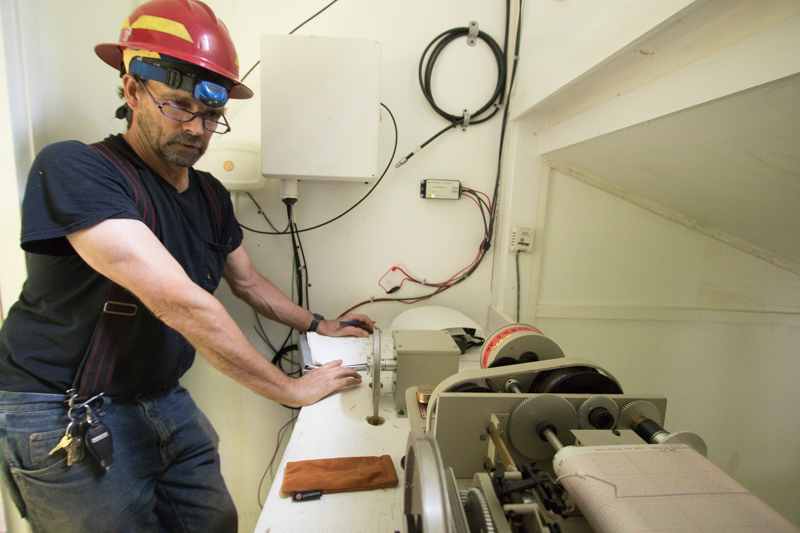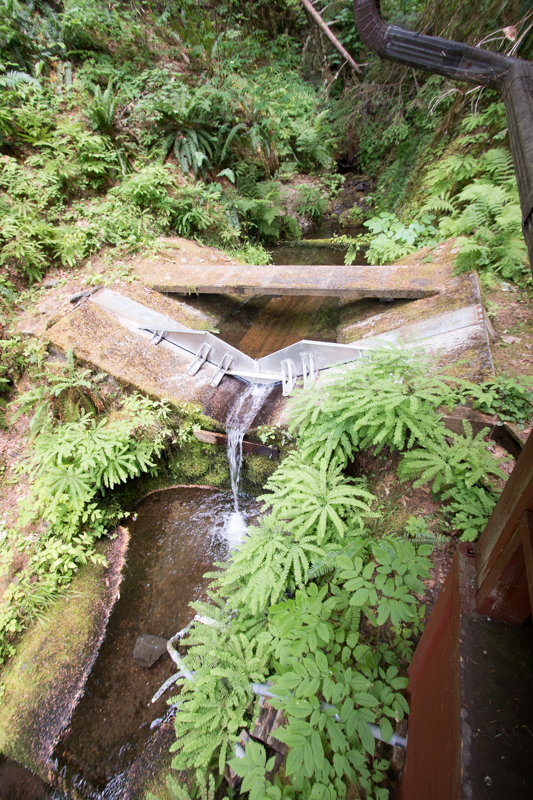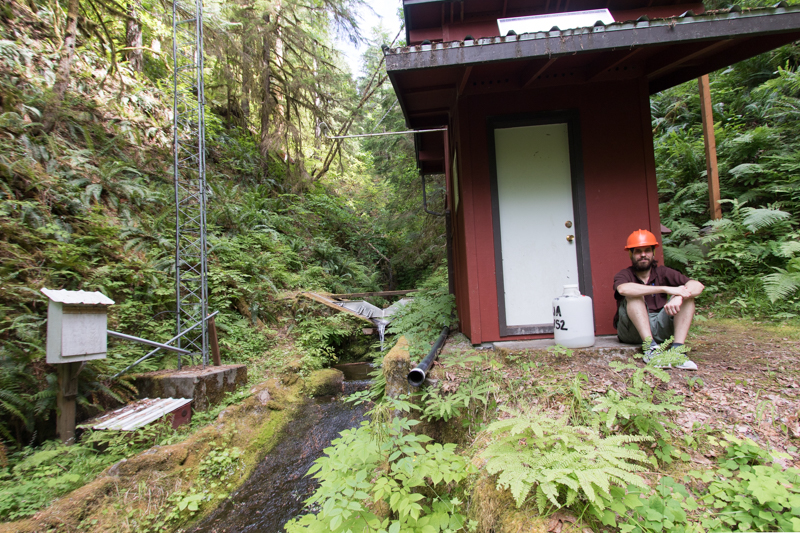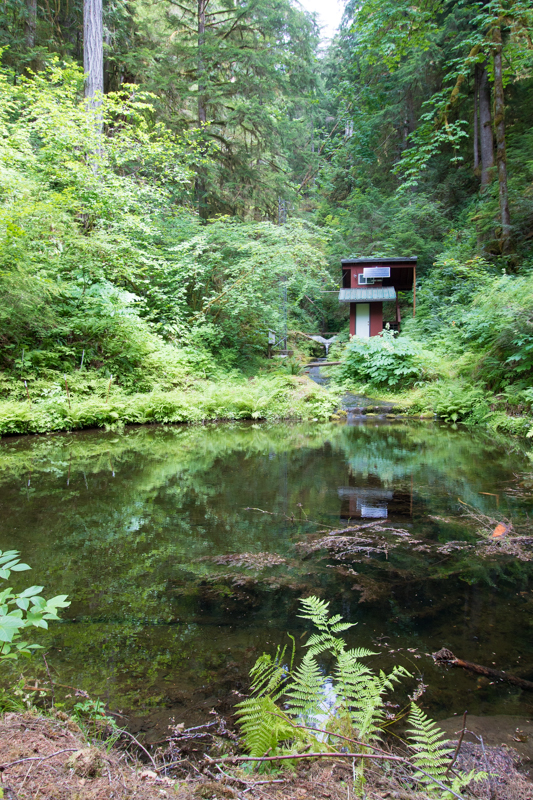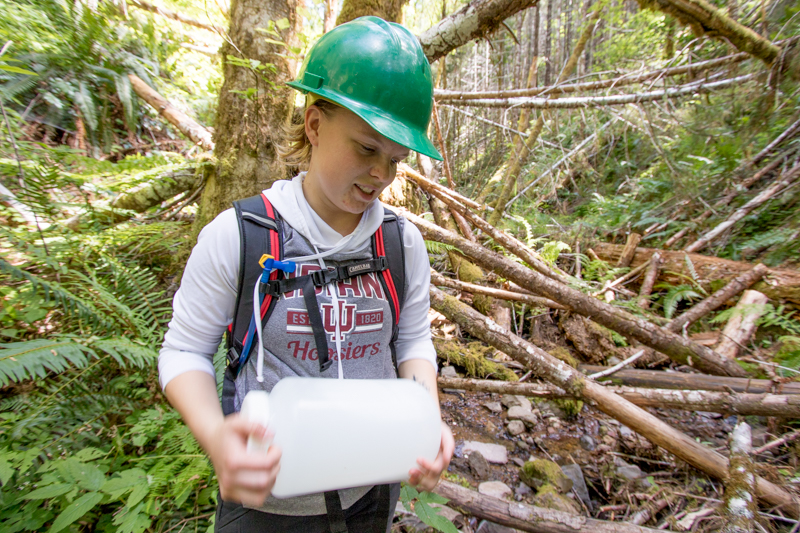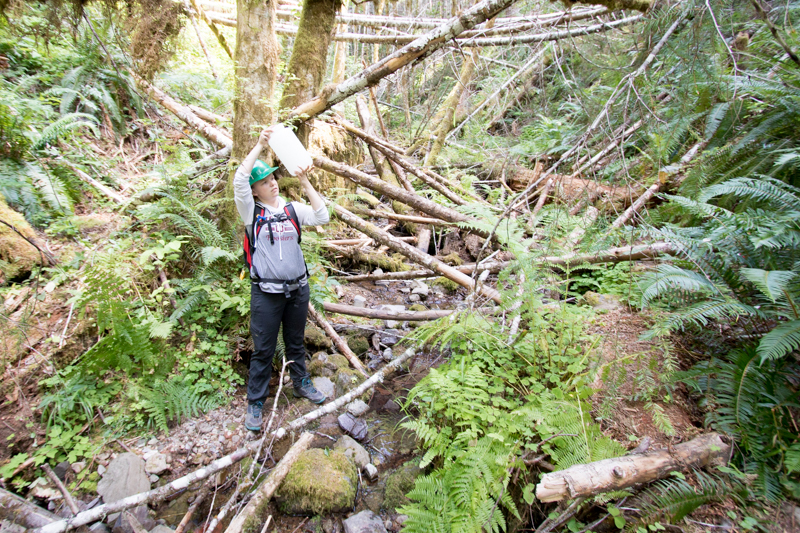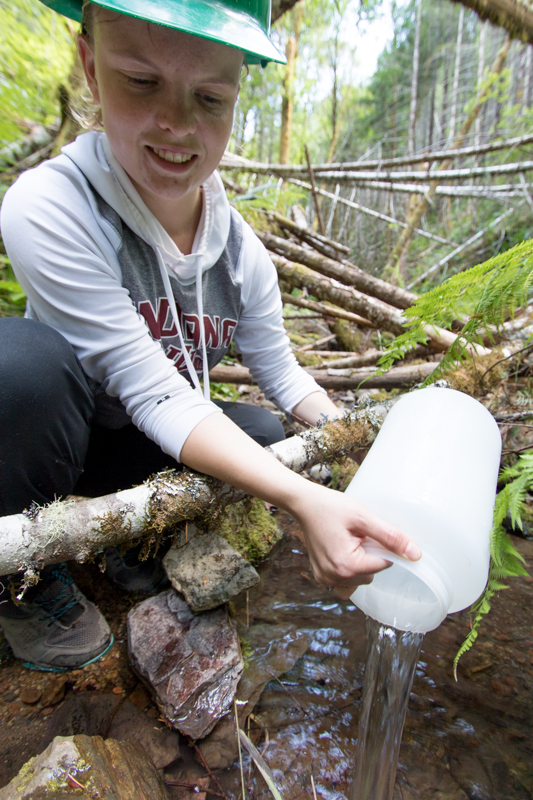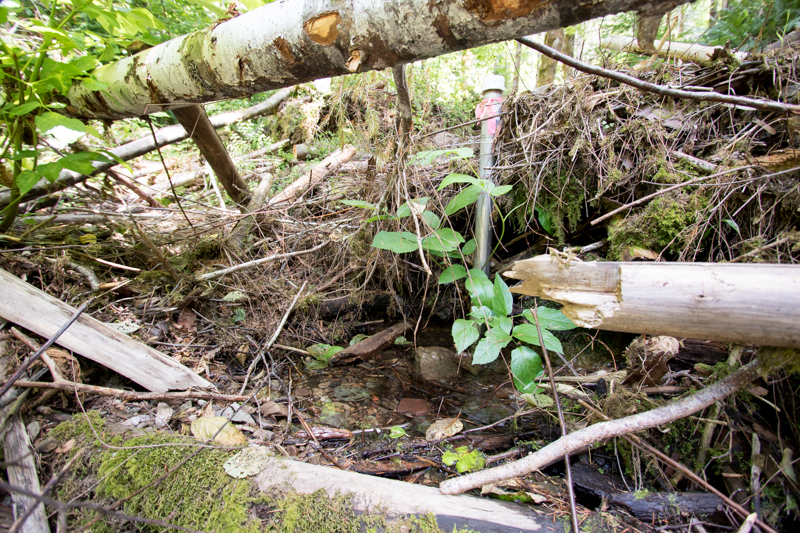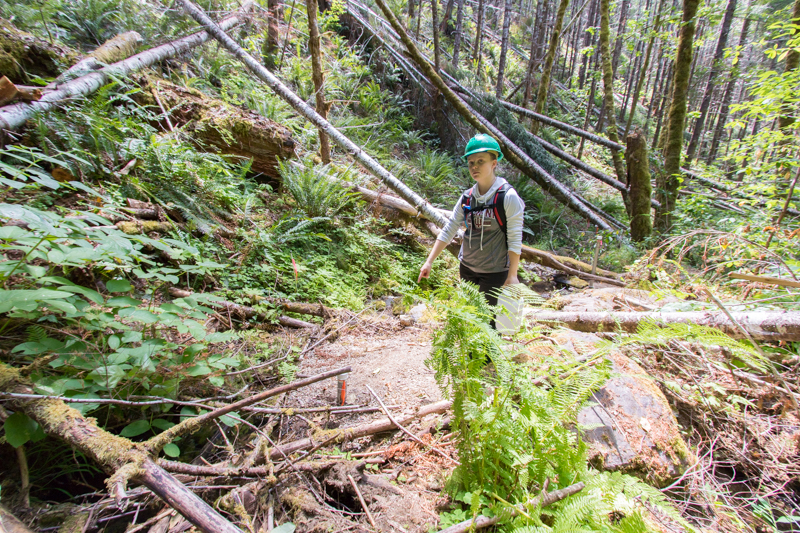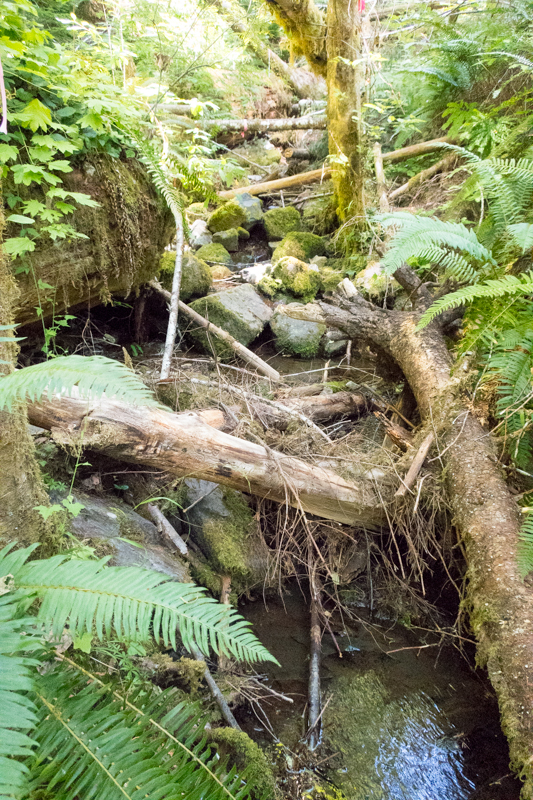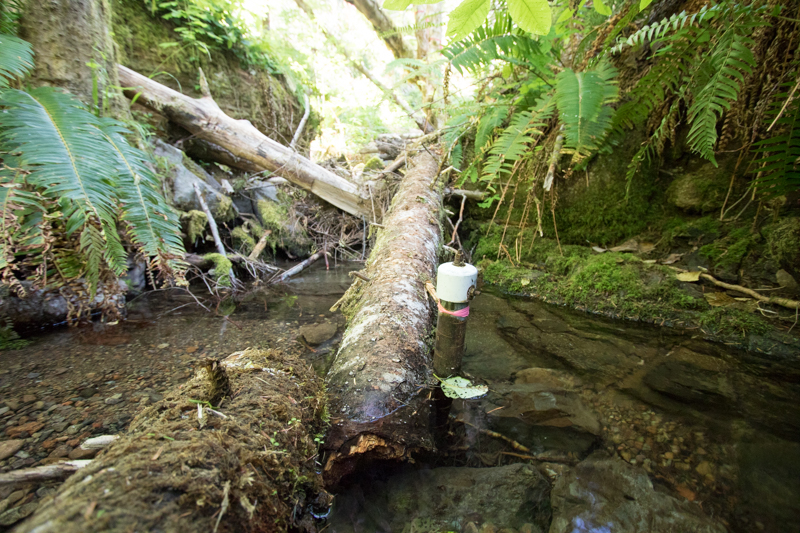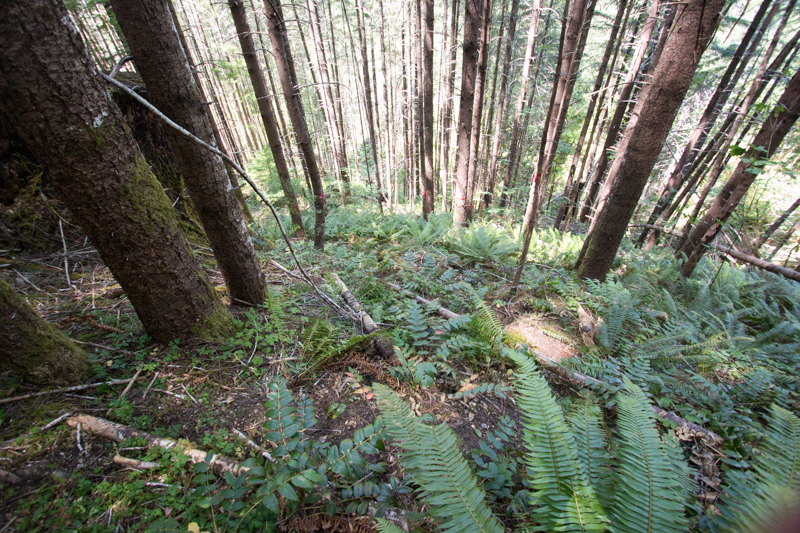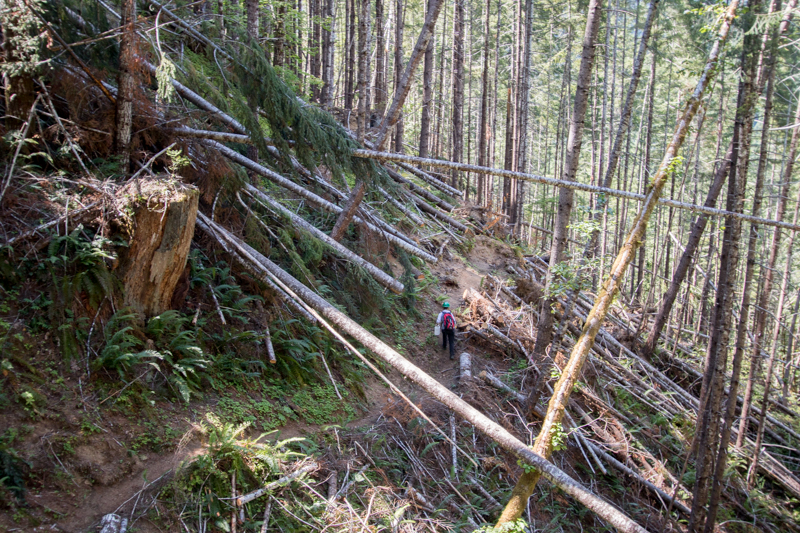Lower Lookout Creek, near headquarters
Hydrology Field Work 2019
The stream cross-section profiles in the Andrews Experimental Forest study (see more at dataset GS002) was established to monitor long-term changes in channel cross-sectional geometry (width, depth) in response to storms and change in the disposition of large organic debris in a range of stream sizes beginning in 1978. These observations can be used to assess change in sediment storage within the sample reach and change in habitat structure. OSU graduate student Arianna Goodman resampled the cross sections in 2019 as part of her graduate study.
The Watershed 02 stream gage (see more at dataset HF004) was set up in 1952 as part of a larger paired, gaged watershed study to detect changes in streamflow due to watershed treatments. Data continue to be collected on streamflow and stream chemistry from the gage. Sediment data from the stream is measured periodically to assess load and accumulation. See more about the Experimental Watersheds and Gauging Stations at the Andrews Forest.
Paige is a PhD student from Indiana University studying how water moves into and out of the hyporheic zone in Watershed 01. Paige’s research builds on decades of past research that has taken place in WS01 and extends our knowledge of what drives hyporheic exchange in mountain streams.
Lower Lookout Creek, near headquarters
Nicolas Vergara, watershed technician, visiting from Universidad Austral de Chile, Valdivia, Chile, in Lookout Creek, near headquarters
(from L to R:) Alberto Paredes, visiting researcher from Universidad Austral de Chile, Valdivia, Chile, and Arianna Goodman, graduate student OSU, holding a Real Time Kinematic (RTK) GPS receiver to make precise measurements of positions in the stream as part of the study, "stream cross-section profiles in the Andrews Experimental Forest."
(from L to R:) Alberto Paredes, visiting researcher from Universidad Austral de Chile, Valdivia, Chile, and Arianna Goodman, graduate student OSU, holding a Real Time Kinematic (RTK) GPS receiver to make precise measurements of positions in the stream as part of the study, "stream cross-section profiles in the Andrews Experimental Forest."
(from L to R:) Alberto Paredes, visiting researcher from Universidad Austral de Chile, Valdivia, Chile, and Arianna Goodman, graduate student OSU, converse with Greg Downing, USFS Hydrologic Technician, on the location and history of stream cross-section locations in Lookout Creek
a map, created in 1990 by Nakamura and Swanson, of the stream channel in lower Lookout Creek. The map, depicting the channel morphology and the location of sample cross sections, is used as a reference for the 2019 survey of the stream cross section locations.
OSU graduate student Arianna Goodman holds a 1990 map of the stream chanel and cross section locations in lower Lookout Creek.
OSU graduate student Arianna Goodman holds a 1990 map of the stream chanel and cross section locations in lower Lookout Creek.
Lower Lookout Creek, near headquarters
USFS Hydrologic Technician Greg Downing, at Lower Lookout Creek, near headquarters
Lower Lookout Creek, near headquarters
Lower Lookout Creek, near headquarters
Lower Lookout Creek, near headquarters
Lower Lookout Creek, near headquarters
The stream gage house and flume with low flow v-notch weir plate attached.
The stream gage house and flume with low flow v-notch weir plate attached.
Nicolas Vergara, watershed technician, Universidad Austral de Chile, Valdivia, Chile, and Greg Downing, USFS Hydrologic Technician, at the gage house and flume in Watershed 02
Greg Downing, USFS Hydrologic Technician, maintains the water sampler battery power for the gage house in Watershed 2. The water sampler and data logger batteries are charged by a solar panel.
Greg Downing, USFS Hydrologic Technician, prepares to take a water chemistry sample in Watershed 02
USFS Hydrologic Technician Greg Downing, and visiting researcher Nicolas Vergara, prepare a water chemistry sample from Watershed 02
USFS Hydrologic Technician Greg Downing, and visiting researcher Nicolas Vergara, prepare a water chemistry sample from Watershed 02
Greg Downing, USFS Hydrologic Technician, maintains the automated water sampler in the Watershed 02 gage house
The WS02 stream gage house and flume with low flow v-notch weir plate attached.
The WS02 stream gage house and flume with low flow v-notch weir plate attached.
The WS02 stream gage house and flume with low flow v-notch weir plate attached.
The WS02 stream gage house and flume with low flow v-notch weir plate attached.
Nicolas Vergara, watershed technician, Universidad Austral de Chile, Valdivia, Chile, and Greg Downing, USFS Hydrologic Technician, at the gage house and flume in Watershed 02
Visiting researcher Nicolas Vergara reads the hook gauge to determine stream stage (water depth) in the flume
USFS Hydrologic Technician Greg Downing, makes notations on the streamflow data collected by a Model 2, Stevens Water Monitoring Systems, Position Analog Transmitter (PAT) controlled by a Campbell Scientific CR-1000 data logger.
USFS Hydrologic Technician Greg Downing, makes notations on the streamflow data collected by a Model 2, Stevens Water Monitoring Systems, Position Analog Transmitter (PAT) controlled by a Campbell Scientific CR-1000 data logger
USFS Hydrologic Technician Greg Downing annotates a continuous graphic record of stream stage fluctuations taken by a Stevens Type A-71 recorder
The flume with low flow v-notch weir plate attached, in Watershed 02. The flume is used to measure the volume of water leaving the watershed. The flume, and streamflow record, started in 1952. Stream chemistry measurements began in 1981.
Visiting researcher Nicolas Vergara, watershed technician, from the Universidad Austral de Chile, Valdivia, Chile, at the gage house of Watershed 02
Instrumentation in Watershed 2: The Campbell Scientific CR-1000 data logger collects stream stage (i.e., water depth) in the flume, air temperature, water temperature, and water conductivity data. It also triggers the automated Hach/Sigma water sampler to sample, based on stage height. The water samplers are set up as proportional samplers to sample more often as the stream stage rises. The data logger keeps track of when the sampler is to collect a sample. The CR10X data loggers were installed in 1999. The Cr-10x's data loggers were replaced with CR-1000's in 2015.
Instrumentation in Watershed 2: The Campbell Scientific CR-1000 data logger collects stream stage (i.e., water depth) in the flume, air temperature, water temperature, and water conductivity data. It also triggers the automated Hach/Sigma water sampler to sample, based on stage height. The water samplers are set up as proportional samplers to sample more often as the stream stage rises. The data logger keeps track of when the sampler is to collect a sample. The CR10X data loggers were installed in 1999. The Cr-10x's data loggers were replaced with CR-1000's in 2015.
The gage house and sediment basin in Watershed 02
The gage house and sediment basin in Watershed 02
Indiana University graduate student, Paige Becker, conducts salt tracer experiments in Watershed 01
Indiana University graduate student, Paige Becker, conducts salt tracer experiments in Watershed 01
Indiana University graduate student, Paige Becker, conducts salt tracer experiments in Watershed 01
Indiana University graduate student, Paige Becker, conducts salt tracer experiments in Watershed 01
Wells in Watershed 01 at the Andrews Forest. The wells are used to sample the water deep in the streambed material
Graduate student, Paige Becker, points out a water well in the soil. The well had been placed originally in the center of the streambed, showing how the water chanel moves over time.
Graduate student, Paige Becker, with a pressure transducer that measures the head gradient in the streambed.
Wells in Watershed 01 at the Andrews Forest. The wells are used to sample the water deep in the streambed material
Graduate student, Paige Becker, with a sampling device that measure electrical conductivity of the water
the stream in Watershed 01 in the HJ Andrews Experimental Forest LTER site
hydrology well in Watershed 01 in the HJ Andrews Experimental Forest LTER site
the stream in Watershed 01 in the HJ Andrews Experimental Forest LTER site
Looking down the north slope, toward the streambed, in Watershed 01
Graduate student Paige Becker looks down the north slope of Watershed 01, where a heavy snow brought down many trees in late spring

